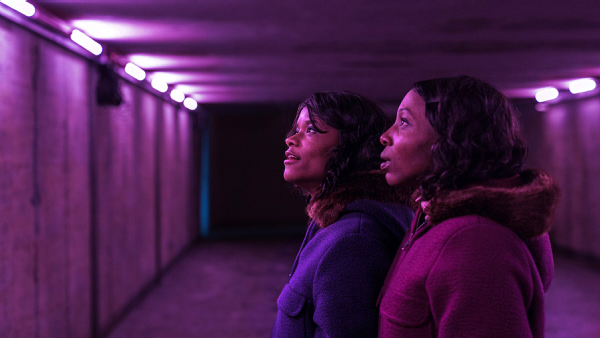Movie review by Greg Carlson
Making her English-language feature debut, Polish filmmaker Agnieszka Smoczyńska fails to replicate the quality and originality of either of her previous two movies. Both “The Lure,” which received a warm home media welcome from the Criterion Collection, and “Fugue” attracted well-deserved attention for Smoczyńska’s storytelling instincts and bold visual choices. “The Silent Twins,” adapted from Marjorie Wallace’s 1986 book of the same title, has all the makings of an intensely dramatic “based on a true story” experience. But the screenplay by novelist Andrea Seigel struggles to make sense of the unorthodox relationship of the protagonists.
June Gibbons (played as a child by Leah Mondesir-Simmonds before Letitia Wright takes over) and Jennifer Gibbons (Tamara Lawrance provides the grown-up version and Eva-Arianna Baxter plays the younger one) were twin sisters born in a military hospital in Yemen in 1963 to Caribbean immigrants who lived in England and later in Wales. Developing a fierce codependence, the girls spoke a speedily-enunciated Bajan Creole based on dialect from their parents’ native Barbados. Victimized by racist school bullies, June and Jennifer would further develop their cryptophasia, eventually shutting out all others and communicating almost exclusively with one another.
Smoczyńska opens the film with the voices of the young June and Jennifer narrating the credits. Matched with handmade artifacts that will recur in stop-motion sequences placed throughout the film, the promising start echoes the legendary title sequence Stephen Frankfurt designed for “To Kill a Mockingbird.” Frankfurt said that his goal was “to find a way to get into the head of a child,” and that is precisely the feeling emanating from the first frames of “The Silent Twins.” Soon, Lawrance and Wright will convey the peaks and valleys of the intimate connection between June and Jennifer.
Echoing the challenge faced by the mermaid sisters in “The Lure,” the most engaging section of “The Silent Twins” unfolds when the sisters seek out the companionship of an American teenager (Jack Bandeira) who is more than willing to provide the carnal education sought especially by Jennifer. The music cues, costumes, and choreography on display in these segments sparkle with vitality. Later, once the twins are committed to Broadmoor, the terrifying, high-security psychiatric hospital where they were held for years, the movie shifts toward a preoccupation with unpleasant conditions and the key conundrum facing the Gibbons siblings: abandon their secret language/connection and secure freedom or stick with it and be held under lock and key.
Jon Amiel directed a made-for-TV version of “The Silent Twins” for the BBC in 1986. The screenplay for that edition was written by Wallace the same year her book was published. I have not seen the movie, but would love to compare versions separated by more than 35 years. In this latest piece, both Lawrance and Wright deserve credit for depicting the idiosyncratic personalities of Jennifer and June – loving and fighting as artistic collaborators and jealous rivals – but “The Silent Twins” plugs away without the urgency or rising stakes that would invite viewers to identify with the special world inhabited by the women.
